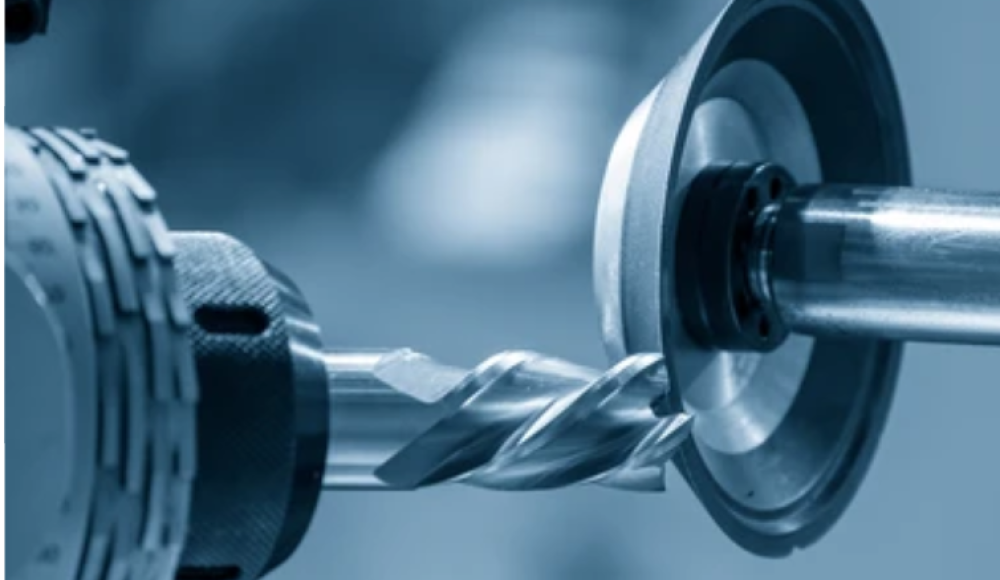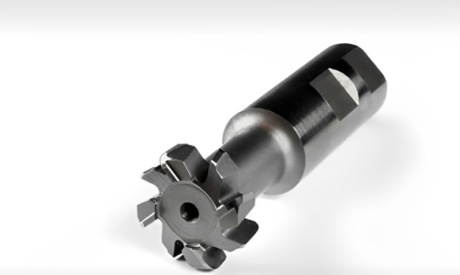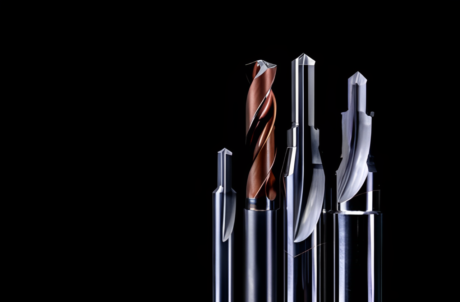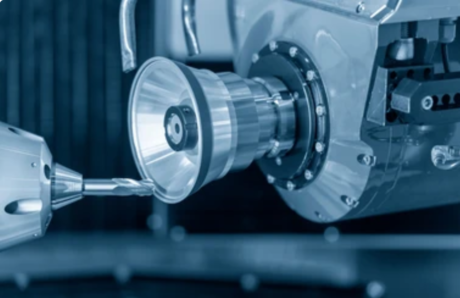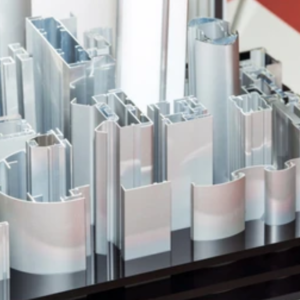La fresatura finale è un tipo di operazione di lavorazione necessaria. È il raggiungimento di molte forme diverse essenziali nelle industrie. Impiega utensili da taglio noti come frese che hanno lo scopo di eliminare il materiale eseguendo il movimento su vari piani attorno al pezzo in lavorazione. oltre a questo, è costoso ma molto utile per creare strutture complesse e superfici fini. COSÌ, in questo articolo, discuteremo la definizione di fresatura, le caratteristiche della fresatura, ed alcuni confronti con altri tipi di fresatura. Aiuteranno il produttore a prendere le decisioni corrette sull'utilizzo della fresatura.
Che cosa ios Fresatura finale?
La fresatura è una delle tecniche di lavorazione più comuni. Qui gli utensili da taglio montati su un mandrino vengono utilizzati per rimuovere il materiale dal pezzo mediante il loro movimento rotatorio. Il tipo di utensile da taglio utilizzato è chiamato fresa, che ha bordi taglienti all'estremità e lateralmente. Consentono il taglio assiale e radiale del pezzo. Questa operazione ha molte applicazioni per formare elementi come le fessure, contorni, profili, e fori in materiali diversi. Questi possono includere metalli, plastica, eccetera. La fresatura a candela è importante per via dei numerosi vantaggi rispetto ad altri metodi. Questi possono essere un alto livello di precisione, flessibilità nella realizzazione di bordi ripidi, e una migliore produzione cronologica. oltre a questo, può aiutare a creare complessità geometriche in un ciclo.
Come fa il processo di fresatura finale funziona?
La fresatura finale è anche un altro termine usato per il taglio finale. Si tratta di uno strumento o di una fresa che ruota a una determinata velocità. Quindi vengono inseriti nel pezzo in lavorazione e vengono utilizzati per radere via le parti desiderate nel prodotto finale. L'utensile da taglio ha una punta e lati affilati che gli consentono di tagliare in tutte le direzioni. COSÌ, questo lo rende molto versatile e gli permette di realizzare forme complesse. Ecco come funziona il processo in dettaglio:
1. Taglio assiale
In questa operazione, la fresa è generalmente in direzione verticale rispetto al pezzo. Ciò ha molte applicazioni in un processo che aiuta a creare rientranze come fori o tasche sul materiale. L'azione di taglio avviene principalmente nella parte terminale della fresa. COSÌ, taglia mentre si muove verso il basso con un tuffo deciso.
2. Taglio radiale
Qui, la fresa trasla lungo il piano XY del pezzo in modo macro. Questo movimento aiuta a generare funzionalità come gli slot, profili, o contorni. I taglienti laterali situati sui fianchi della fresa tagliano il pezzo mentre l'utensile trasla lungo il piano del pezzo.
3. Taglio elicoidale
Questo è un movimento più completo e qui la fresa può essere spostata in direzione assiale o verticale, nonché radiale o orizzontale. Ciò rende possibile formare forme come scanalature a spirale, discussioni, o diversi tipi di funzionalità. Queste direzioni di movimento sono in combinazione tra loro. COSÌ, consente la creazione di geometrie altrimenti molto dure quando si utilizzano altri utensili da taglio.
Proprietà delle fresatrici a candela
Le fresatrici a candela utilizzano una varietà di operazioni, i.e. fresatura frontale, fresatura di profili, e fresatrici a tuffo. Le caratteristiche principali includono:
- Mandrini ad alta velocità: Viene utilizzato come uno strumento che può ruotare ad alta velocità in giri al minuto per soluzioni di taglio rapido.
- Opzioni di utensili versatili: Tieni un assortimento di frese, entrambi piatti, naso a palla, e forme del raggio d'angolo.
- Controllo di precisione: Sofisticati sistemi computerizzati a controllo numerico hanno lo scopo di ottimizzare il funzionamento delle frese e le loro traiettorie.
- Rigidità e stabilità: Le macchine sono costruite per ridurre le vibrazioni. COSÌ, possono garantire l'assenza di deviazioni nella precisione del lavoro.
- Sistemi di raffreddamento: Il calore è controllato da sistemi integrati e la durata degli strumenti viene mantenuta.
Come Does Il tipo di materiale influisce sulla scelta degli utensili per frese?
Il tipo di materiale utilizzato influenza notevolmente la decisione su quale fresa utilizzare. Alluminio è più morbido, quindi il tagliente è spesso affilato e ad alta velocità. Ha uno strato per prevenire l'accumulo di materiale sull'utensile. Ferrosi e alcuni metalli non ferrosi come acciaio e titanio, richiedono punte come frese di metalli più pesanti come carburo o cobalto e talvolta con rivestimenti di trattamento speciali. COSÌ, possono ridurre gli effetti del calore e dell'abrasione. Ulteriore, la forma della fresa, numero di flauti, e l'angolo dell'elica deve essere correlato al tipo di materiale. Quindi consentiranno un'adeguata evacuazione del truciolo e ridurranno l'usura dell'utensile.
Suggerimenti di progettazione necessari per un'operazione di fresatura efficiente
COSÌ, discutiamo alcuni degli importanti suggerimenti di progettazione per rendere più efficaci le operazioni di fresatura finale.
- Ottimizza la pianificazione del percorso utensile: Prendere in particolare considerazione i movimenti dell'utensile durante il taglio. COSÌ, può aiutare a ridurre il tempo di inattività dello strumento.
- Seleziona la geometria dello strumento giusto: Selezionare le frese a candela in base al numero e al numero di scanalature e all'angolo dell'elica. Indipendentemente dal tipo di materiale e dall'operazione, l'angolo di inclinazione della punta deve essere appropriato.
- Controllo dei parametri di taglio: Aiuterà a gestire e variare la velocità del mandrino, velocità di avanzamento, e profondità di taglio. oltre a questo, può ottimizzare la velocità di rimozione del materiale e aumentare la durata dell'utensile.
- Utilizzare un bloccaggio adeguato: Bloccare il pezzo per ridurre le vibrazioni. COSÌ, può essere più semplice ottenere una finitura più accurata.
- Applicare il refrigerante in modo strategico: Di temperatura, il calore deve essere controllato mediante l'uso di refrigerante o getto d'aria. Alla fine ridurrà la quantità di accumulo di trucioli e migliorerà la longevità dell'utensile.
Fresatura finale vs. Macinazione Tradizionale
La tabella seguente ti aiuterà a comprendere la principale differenza tra fresatura finale e fresatura tradizionale.
| Aspetto | Fine fresatura | Macinazione Tradizionale |
| Utensileria | Utilizza frese con taglienti sia sulle punte che sui lati. | Utilizza frese con denti sulla periferia. |
| Operazioni | Può eseguire varie operazioni in più direzioni. | Tipicamente limitato alla fresatura periferica o frontale. |
| Flessibilità | Alto, adatto per geometrie complesse. | Meno flessibile, meglio per forme più semplici. |
| Precisione | Alta precisione e tolleranze strette. | Precisione moderata. |
| Velocità | Più veloce, soprattutto con macchine CNC. | Più lento in confronto. |
Diversi materiali adatti alla fresatura
Qui abbiamo selezionato alcuni materiali più adatti al processo di fresatura finale.
| tipo di materiale | Durezza (Rockwell) | Velocità di taglio (m/min) | Materiale dello strumento |
| Leghe di alluminio | 30-50 HRB | 150-400 | HSS o metallo duro |
| Acciaio | 45-65 HRC | 50-120 | Carburo o Cobalto |
| Acciaio inossidabile | 40-55 HRC | 30-90 | Carburo |
| Leghe di titanio | 30-45 HRC | 20-60 | Carburo o CBN |
| Plastica (Acrilico, addominali) | 10-20 HRB | 300-600 | HSS |
Applicazioni della fresatura
Le seguenti sono le applicazioni della fresatura finale:
- Industria automobilistica: Produzione di parti di motori, grondaie, e stampi.
- Industria aerospaziale: Produzione di articoli che richiedono disegni complessi come le pale delle turbine e le strutture degli aerei.
- Dispositivi medici: In fusione, sanguinamento con produzione di fette e lavorazione degli impianti.
- Elettronica: Infatti, la produzione degli involucri e dei connettori è importante.
- Costruzione di utensili e matrici: Creazione di stampi, matrici e altri strumenti specializzati.
Quando scegliere una fresatura finale?
Per la finitura sono preferibili le frese a candela, adattamento, e la capacità di produrre forme aggressive. È possibile utilizzarli per la scanalatura, profilazione, e contornatura. oltre a questo, è particolarmente utilizzato nei progetti in cui i livelli di tolleranza sono complessi e stringenti. Le frese vengono utilizzate soprattutto quando la programmazione prevede lavori di perforazione, sotto il quale ci sono dei buchi, slot, o in funzionamento ramificato. Hanno tutti diversi spessori di plastica, metalli, eccetera.
Vantaggi della fresatura finale
COSÌ, i seguenti sono i vantaggi della fresatura finale:
1- Alta precisione e tolleranze superficiali.
2- Trasporti in varie direzioni, e movimento flessibile in due direzioni.
3- La capacità di lavorare come una macchina su forme complesse.
4- Dovrebbe applicarsi con una varietà di tipi di materiali.
5- Finiture superficiali di alta qualità.
Svantaggi della fresatura finale
COSÌ, i limiti della fresatura finale sono:
1-Richiede strumenti e attrezzature specifici per il tipo di materiale.
2-È probabile che la finitura fine richieda molto tempo. oltre a questo, è probabile che anche l'utensile da taglio si usuri rapidamente, soprattutto se il materiale è molto duro.
3-L'acquisto di alcune delle macchine più sviluppate potrebbe essere inizialmente più costoso.
4-L'alto livello di programmazione richiesto quando si utilizza il CNC per diverse operazioni.
Conclusione
Insomma, la fresatura è uno dei processi più utilizzati nel settore. Ciò è dovuto principalmente alla sua flessibilità geometrica, maggiore precisione, e migliore finitura superficiale. Conoscerne le caratteristiche, prezzi, e l'utilizzo può aiutare i produttori a investire in esso per migliorare la qualità dei loro prodotti. La decisione verso la scelta corretta degli strumenti, materiali, e i parametri di lavorazione rendono il processo di fresatura uno dei metodi più efficienti ed economici.
Domande frequenti
Q1. Qual è la differenza tra fresatura frontale e fresatura finale?
Nella fresatura, la fresa ruota sul proprio asse e contemporaneamente si muove linearmente per asportare il materiale. D'altra parte, nella fresatura frontale, la fresa si muove in una sola operazione lungo l'asse Y dopodiché il materiale viene dragato. Inoltre, nella fresatura finale, i taglienti si trovano all'estremità e sui lati dell'utensile. Nella fresatura frontale, l'utensile ha taglienti solo sulla faccia.
fresatura frontale e fresatura finale in dettaglio.
Q2. Quali fattori dovrei considerare per scegliere la fresa giusta per il materiale??
Può basarsi sulla durezza del materiale o sulla velocità di taglio. oltre a questo, deve considerare la geometria dell'utensile per il taglio.
Q3. Quali materiali sono più adatti per le operazioni di fresatura?
È meglio eseguire la fresatura finale alluminio, acciaio, titanio, e alcune materie plastiche.
Q4. Le frese possono essere utilizzate per la foratura?
È possibile utilizzare alcune frese come trapano. Tuttavia, questa non è la sua funzione principale.
Q5. Quali fattori influenzano la durata dell'utensile nella fresatura?
Diversi fattori possono avere un impatto sulla vita dell’utensile. Questi possono includere la durezza del materiale, velocità di taglio, velocità di avanzamento, materiale dell'utensile utilizzato, e applicazione del liquido refrigerante.

